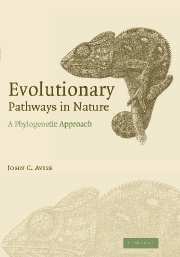Book contents
- Frontmatter
- Contents
- Preface
- Acknowledgments
- 1 Introduction
- 2 Anatomical structures and morphologies
- 3 Body colorations
- 4 Sexual features and reproductive lifestyles
- 5 More behaviors and ecologies
- 6 Cellular, physiological, and genetic traits
- 7 Geographical distributions
- Epilog
- Appendix: a primer on phylogenetic character mapping
- Glossary
- References and further reading
- Index
1 - Introduction
Published online by Cambridge University Press: 18 December 2009
- Frontmatter
- Contents
- Preface
- Acknowledgments
- 1 Introduction
- 2 Anatomical structures and morphologies
- 3 Body colorations
- 4 Sexual features and reproductive lifestyles
- 5 More behaviors and ecologies
- 6 Cellular, physiological, and genetic traits
- 7 Geographical distributions
- Epilog
- Appendix: a primer on phylogenetic character mapping
- Glossary
- References and further reading
- Index
Summary
Long before the concept of biological evolution entered the human mind, people classified diverse forms of life into recognizable categories. Some of the earliest spoken words undoubtedly were names ascribed by primitive peoples to particular types of plants and animals important in their daily lives. Theorists and professional biologists categorized organisms too. For example, in the third century BC the Greek philosopher Aristotle grouped species according to morphological conditions (such as winged versus wingless, and two-legged versus four-legged) that he supposed had been constant since the time of Creation. About twenty centuries later, Carolus Linnaeus – a Swedish botanist and the acknowledged father of biological taxonomy – classified organisms into nested groups (such as genera within families within orders within classes), but still he had no inkling that varied depths of evolutionary kinship might underlie these hierarchical resemblances.
More time would pass before scientists finally began to understand that life evolves, and that historical descent from shared ancestors was responsible for many of the morphological similarities among living (and fossil) species. This epiphany is sometimes mistakenly attributed to Charles Darwin (CD), but several scientists before him in the late 1700s and early 1800s, including Jean-Baptiste Lamarck, Comte de Buffon, and CD's own grandfather Erasmus Darwin, were well aware of the reality of evolutionary descent with modification. What CD “merely” added was the elucidation of natural selection as the primary driving agent of adaptive evolution (this achievement was, of course, one of the most influential in the history of science).
- Type
- Chapter
- Information
- Evolutionary Pathways in NatureA Phylogenetic Approach, pp. 1 - 18Publisher: Cambridge University PressPrint publication year: 2006



